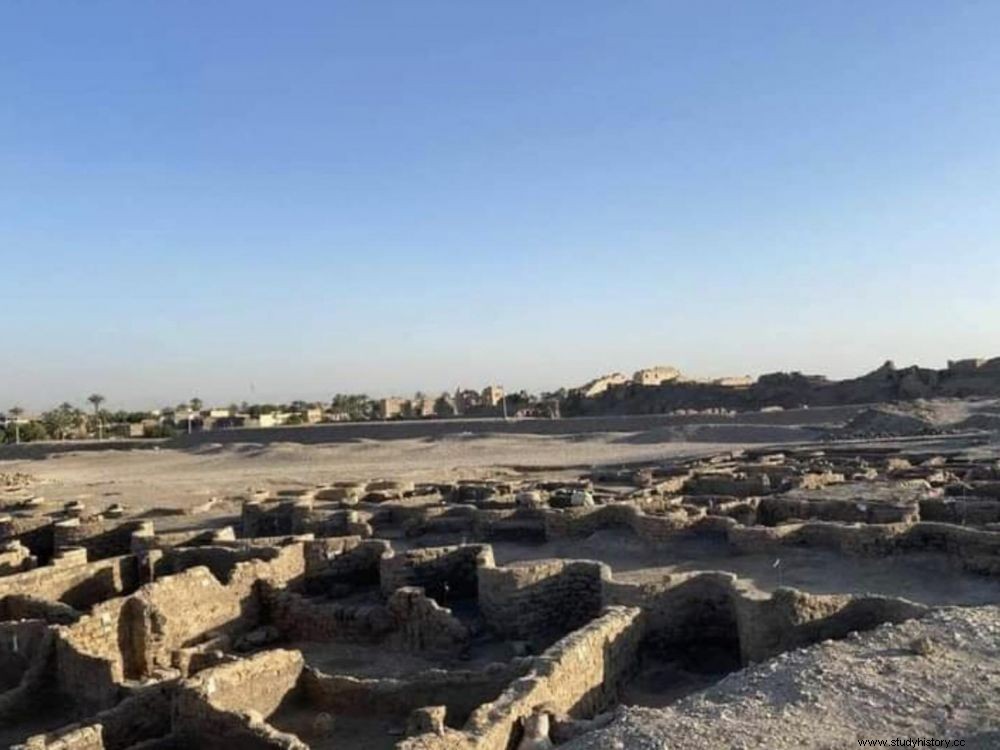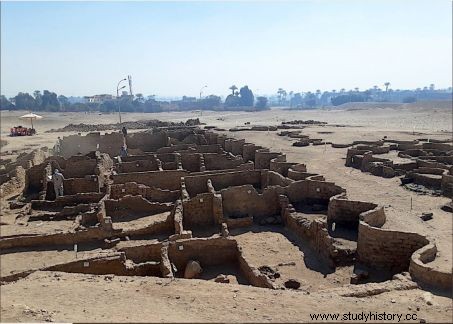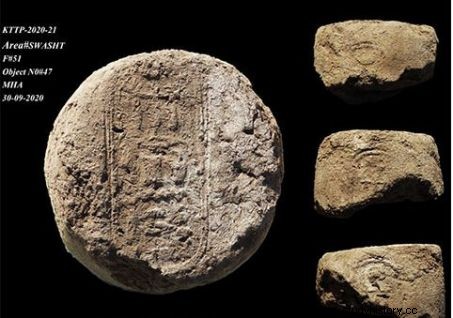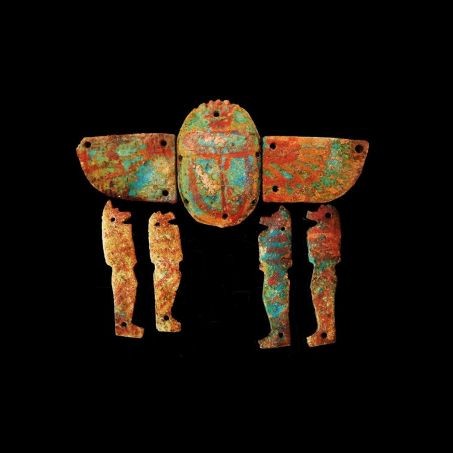Egyptian authorities have announced the discovery of a "lost city" of the New Kingdom, contemporary to the reign of Amenhotep III, near Luxor, Egypt.

The walls of a 3,000-year-old city active during the reigns of Pharaohs Amenhotep III and his son Amenhotep IV (Akhenaten) have been discovered near Luxor, Egypt.
The emotion must have been palpable when the first burnished mudbrick walls appeared. It is indeed the exhumation of a "lost city" over 3000 years old, on the west bank of ancient Thebes, that the Egyptian Ministry of Antiquities has just reported in a press release. An agglomeration baptized "The Ascension of Aten" by its discoverer, the famous Egyptologist and former Minister of Antiquities, Zahi Hawass.
Between the temple of Ramses II and that of Amenhotep III
In September 2020, the archaeologist was looking for the funerary temple of Tutankhamun - which he believed he could locate in the region where those of his two successors Aÿ then Horemheb were. It was then that brick walls with undulating shapes emerged from under the sands. The remains of a very well-preserved city, founded by Amenhotep III, the 9th king of the 18th dynasty, according to the Egyptian daily Luxor Times .
 Another view of the "lost city" located on the west bank of ancient Thebes. Credits:Zahi Hawass
Another view of the "lost city" located on the west bank of ancient Thebes. Credits:Zahi Hawass
The new city would thus be between the temple of Ramses II and that "of millions of years" of Amenhotep III, at Kôm el-Hettan. This area had already apparently been partially explored in the 1930s by Clément Robichon and Alexandre Varille, of the Institute of Oriental Archeology in Cairo, according to the Spanish Egyptologist José Miguel Para, who spoke in the pages of La Vanguardia . With walls sometimes 3m high, the city delivered dwellings with rooms filled with everyday life tools.
Rings and beetles. Even a bakery!
Hieroglyphic inscriptions identified on clay caps would refer to royal palaces of King Amenhotep III. Rings, scarabs, colored pottery and clay bricks would also bear the royal cartouche of Amenhotep III ( Neb-Maat-Re to the West of Thebes ), confirming the age of the city, according to the press release.
 Remains of cartouches with the names of pharaohs. Credits:Zahi Hawass
Remains of cartouches with the names of pharaohs. Credits:Zahi Hawass
After seven months of excavations, several sectors have been cleared. In the southern part, a bakery has even been detected, with a space for food preparation, including ovens and storage pottery.
In another district still under study could be located the administrative and residential part of the city, with larger and well-appointed units.
The emotion must have been palpable when the first burnished mudbrick walls appeared. It is indeed the exhumation of a "lost city" over 3000 years old, on the west bank of ancient Thebes, that the Egyptian Ministry of Antiquities has just reported in a press release. An agglomeration baptized "The Ascension of Aten" by its discoverer, the famous Egyptologist and former Minister of Antiquities, Zahi Hawass.
Between the temple of Ramses II and that of Amenhotep III
In September 2020, the archaeologist was looking for the funerary temple of Tutankhamun - which he believed he could locate in the region where those of his two successors Aÿ then Horemheb were. It was then that brick walls with undulating shapes emerged from under the sands. The remains of a very well-preserved city, founded by Amenhotep III on the 9 th king of the 18th dynasty, according to the Egyptian daily Luxor Times .
 Another view of the "lost city" located on the west bank of ancient Thebes. Credits:Zahi Hawass
Another view of the "lost city" located on the west bank of ancient Thebes. Credits:Zahi Hawass
The new city would thus be between the temple of Ramses II and that "of millions of years" of Amenhotep III, at Kôm el-Hettan. This area had already apparently been partially explored in the 1930s by Clément Robichon and Alexandre Varille, of the Institute of Oriental Archeology in Cairo, according to the Spanish Egyptologist José Miguel Para, who spoke in the pages of La Vanguardia . With walls sometimes 3m high, the city delivered dwellings with rooms filled with everyday life tools.
Rings and beetles. Even a bakery!
Hieroglyphic inscriptions identified on clay caps would refer to royal palaces of King Amenhotep III. Rings, scarabs, colored pottery and clay bricks would also bear the royal cartouche of Amenhotep III ( Neb-Maat-Re to the West of Thebes ), confirming the age of the city, according to the press release.
 Remains of cartouches with the names of pharaohs. Credits:Zahi Hawass
Remains of cartouches with the names of pharaohs. Credits:Zahi Hawass
After seven months of excavations, several sectors have been cleared. In the southern part, a bakery has even been detected, with a space for food preparation, including ovens and storage pottery.
In another district still under study could be located the administrative and residential part of the city, with larger and well-appointed units. An area of workshops reserved for craftsmen would also have been delimited. "A large number of casting molds for the production of amulets and delicate decorative elements have been collected, further evidence of an activity in the production of decorations for temples and tombs ", explained Zahi Hawass to the newspaper al-Ahram . Spinning and weaving elements were also collected. "Two unusual burials, those of a cow or a bull have been encountered inside a brick structure and are being identified in an attempt to determine the nature of this practice “, chained Zahi Hawass.
 Amulets and scarabs. Credits:Zahi Hawass
Amulets and scarabs. Credits:Zahi Hawass
Among the finds was that of a container with dried meat, with the inscription:"Year 37, meat prepared for the third Heb Sed feast of the slaughterhouse of Kha made by the butcher luwy ". These precious data deliver not only the names of two inhabitants who lived and worked in this city, but above all, still according to Zahi Hawass, they confirm that the city was active during the time of the co-regency of the sovereign Amenhotep III and his son and successor Amenhotep IV. Better known as Akhenaten, he is often described as the heretical pharaoh, the father of Tutankhamun.
Nevertheless, shortly after its creation, the city would have been abandoned and the capital transferred to Tell el-Amarna, in Middle Egypt, the city created ex-nihilo by the sovereign Akhenaten, called "The Horizon of Aten". Zahi Hawass hopes to be able to provide answers to this mysterious disaffection by continuing the excavations. A puzzle that remains to be reconstructed from these crucial years in the history of ancient Egypt.
These works also open windows on town planning and the living environment of the ancient populations of Egypt. To the north of the agglomeration, a large cemetery was encountered, the extent of which remains to be assessed.
